Tramfloc Is Pleased To Announce
We Have Updated Our Site For
Easier Access And A Fresh Face. |
Tramfloc® Polymers , used as water and wastewater polymers, offer many benefits for the plant and process manager and owner. We can achieve lower dosage levels which will produce lower flocculation costs. A faster settling rate can be developed which will increase system throughput. We can help produce a denser underflow which will capture more TSS and thereby yield higher sludge cakes and lower turbidity supernatant. This will allow for a higher product quality where the clarification process is critical to manufacturing a low or no solids' product.
The performance and efficiency of Tramfloc Flocculants are strongly influenced by the selection and application techniques of the chosen product. We recommend specific procedures to evaluate and select Tramfloc polymers tested in your laboratory. This section explains how to prepare and apply solutions of Tramfloc polymers to help ensure accuracy of results and conclusions, ease of testing and cost effectiveness of the Tramfloc Flocculant applied in your liquid/solids separation process. The solubility rate varies with each type and grade of Tramfloc polymer based on its individual ionic charge, characteristics and molecular weight. In general, the higher the weight, the longer it will take to make a reliable testing solution.
Emulsion and dispersion grades of polymer require adequate and effective wetting in order to be of maximum value in the process application. The initial wetting of the polymer with water should be done in a high-shear condition environment of ephemeral duration. In-line static mixers, elaborate make down units and adding polymers to the vortex created by an agitator in a mixing tank are suitable methods.
If testing solution grade polymers such as the Tramfloc 520-530, 620-630, and 720-740 series products described elsewhere on the Tramfloc, Inc. web site, dilution serves only to reduce viscosity so that the solution will mix completely with the process stream to be treated. Merely good agitation will make a workable solution due to the high miscibility of Tramfloc solution polymers.
When producing stock solutions of polymers, they should be prepared at the maximum practical solution strength as dictated by their final solution viscosity which will be about 0.5%. Care should be taken to determine the minimum and maximum solution strength. In general, better performance is obtained from lower strength stock solutions of polymer. In dewatering applications, however, dilute solutions may be undesirable.
Stock solution tanks are normally fitted with a low speed impeller on the agitator shaft. The impeller should be large enough to turn over the viscous polymer solution. For very large stock solution tanks, an agitator with dual impellers should be used. The polymer concentration in the stock tank should always be known. It is a general rule of thumb that the more dilute a stock solution is, the shorter its shelf life. Stock solutions should not be stored more than one day. Laboratory testing should be conducted if the dilution water supply is extremely hard or contains metal cations.
Once the stock solution has been prepared, it can be damaged by high shear conditions. Therefore, superfluous points of high shear should be eliminated and low shear gear or progressive cavity pumps are helpful. The optimum addition point or points for a stock solution should be determined during in-plant trials. The solution addition point is frequently the position at which the process or waste stream is fed into a clarifier or thickener feedwell. The addition of polymer solution in this point of high turbulence usually produces optimum results. Laboratory testing may help indicate whether or not multiple stock solution feed points should be considered. Efficient mixing should follow each separate addition point. When treating concentrated process or waste streams, as typical of filters or centrifuges, a mild mixing stage is usually required. This means that specially designed low speed mixing chambers should be used when conditioning the stream with polymer solution. Polymer solutions fed to centrifuges are normally injected inside the machine or into the feed line.
1. It is advantageous to perform bench scale evaluations in order to reduce the number of potentially successful Tramfloc Flocculants as far as possible. Charge four drops of each Tramfloc emulsion polymer to be evaluated to 100 ml of warm tap water. Return the excess polymer to the sample bottle. You would do well to use 7 or 8 oz. clear plastic cups to contain the dilution water which will be mixed with the Tramfloc polymer. Draw water repeatedly into the syringe from the 100 ml of dilutant after discharging the four drops, about 20 times, until the polymer has been well dispersed into the solution and it has become homogenized. That ratio will produce a 0.1 % polymer solution. Mark each of the solution containers with the Tramfloc polymer product designation. We suggest that the samples stand quiescently for 60 minutes in order to allow the tightly wound polymer chains in Tramfloc polymers to uncoil before they reach their full effectiveness.
2. If you are evaluating Tramfloc dry polymers, weigh 100 mg of polymer and charge very slowly with 3 ml. of isopropanol, acetone or ethanol to initially wet the granules. Then slowly charge 100 ml of tepid tap water. Add the granules almost singly so that they fall into the vortex of the water which is being stirred rapidly, if none of the aforementioned solvents are available. That ratio will produce a 0.1 % polymer solution. Place the beaker on a heated magnetic stirrer for optimum results. Mix until all the granules have disappeared into a homogeneous solution without lumps or fish eyes. Reduce the speed to 50 rpm and after as much as 60 minutes of stirring, a viscous and homogeneous solution should have been formed. The water and granules may be mixed vigorously in a stoppered flask for several minutes before quiescence. Each particle of dry polymer must be wetted with water to insure that a reliable testing solution has been prepared. Allow the solution to uncoil fully by causing the solution to stand quiescently for 120 minutes. Each solution container should be marked with the Tramfloc polymer product number.
3. Charge 1000 ml of untreated sample into a beaker and place in a jar tester. Be sure that the sample you have selected is representative of the plant process, especially with respect to pH, temperature, TSS, homogeneity, biological activity etc. A standard gang stirrer works effectively. Stir samples at high speed while charging the polymer solutions to be tested. Set the stirrer speed at 100-150 rpm and after 3-8 minutes, rapidly charge the desired amount of polymer solution. Then reduce the stirrer speed to 40-50 rpm for 1-2 minutes. Stop the stirrer and observe results for up to 10 minutes. One ml of polymer solution charged to 1.0 L of sample yields a 1.0 ppm polymer feed rate.
4. Initially apply dosages of 1-10 ppm. If no performance is observed, increase the dosage by 5 ppm until you have tested dosages up to 100 ppm. Thereafter, increase dosages by 100 ppm up to 1000 ppm. It is sometimes necessary to adjust pH, as in the case of MeOH precipitation. Tramfloc coagulants may also be required when the flocculant dosages do not reveal desired settling.
5. Continue testing samples until you have applied all Tramfloc polymer solutions in all the appropriate dosage ranges.
6. Observe which sample(s) had the fastest solids' settling rate, largest floc, densest floc mass, clearest supernatant. Congratulations! You have just selected the Tramfloc polymer which should be used to clarify your waste stream. You may now schedule a trial application of the new polymer. Call us with any questions which may arise and please advise us of your final testing results.
1. Follow steps one and two as per the above section to produce polymer solutions for testing purposes.
2. Charge about 100 ml of sludge to be dewatered into a new 7 or 8 oz. clear plastic cup, marked with the Tramfloc polymer to be tested. Add one full syringe of the Tramfloc polymer solution to the sludge and then pour the treated sludge into another clean plastic cup. Transfer the treated sludge sample and back and forth to the original container, four or five times to completely mix the Tramfloc polymer solution and the sludge sample. Experiment with various dosages as the results indicate.
3. Set the conditioned sludge container aside and repeat the entire procedure until you have a 100 ml container of sludge, each treated with a different Tramfloc dewatering polymer.
4. Observe which sample has the largest and densest floc particles, with the clearest supernatant and the largest water cavities around the floc chunks. You have just selected the Tramfloc polymer which should be further tested in a trial application.
Every year, hundreds of millions of dollars are spent on polymers for optimization of water and wastewater treatment liquid/solids separations.
![[Typical Treatment Results]](results.jpg)
Obviously, there are several very important reasons for these vast expenditures:
Aesthetics - People do not want turbid water flowing from their taps or improperly treated wastewater dumped into waterways. Simply stated, pollution is ugly.
Economics - Wastewaters may contain a small amount of a valuable product that can be reclaimed by liquid/solids separation. Or, in areas of limited water supply, the water itself can actually be the valuable commodity that must be reused as many times as possible. The use of flocculants to provide an efficient separation of solids from water may be economically justified if the value of the recovered product offsets the cost of the polymer.
Public Health/Process Needs - Waters and wastewaters very often contain undesirable solids, such as heavy metals, colloidal organics, hardness salts, etc., that usually comprise a very small percentage of the total flow. These waters must be treated to meet individual plant, state, and federal requirements before they are used or discharged. The basic function of flocculants is to increase efficiency of clarification and solids concentration operations.
| The Advantages Of Tramfloc Fluid Flocculants | |
|---|---|
| Over Powdered Flocculants | Over Other Fluid Flocculants |
|
|
|
|
|
|
|
|
|
|
![[Jar Testing]](methods1a.jpg)
|
![[Buchner Funnel Tests]](methods2a.jpg)
|
![[Leaf Filter Tests]](methods3a.jpg)
|
![[Cylinder Tests]](methods4a.jpg)
|
Once a liquid/solids separation problem has been identified, a course of action must be established to achieve the desired results. Very often prior experience is available to help, but there is no substitute for the information obtained from a first-hand bench test. Proper testing enables one to select the best product(s) quickly by visual observations, determine approximate dosages, and experiment with different approaches without danger of plant upset.
Tramfloc's fluid flocculants can be easily evaluated and demonstrated. Various test methods are available, as illustrated above, to screen polymers in the many types of applications and equipment found in water and wastewater treatment plants. For example, the most common test for polymer evaluations is the jar test. Effects of chemical dosage, mixing time, and addition sequence can be observed and compared side-by-side with the current treatment program or any other proposed changes. In addition to jar tests, settling tests using graduated cylinders can also be run to determine the effect of polymer dosage on floc size, settling rate, and sludge compactness. Lastly, Buchner funnels and leaf filters can be used in sludge dewatering applications to predict performance on either vacuum filters or belt presses. All of these tests can be used to screen polymers and program changes, as well as monitor the effectiveness of the treatment program in the plant on a routine basis.
Tramfloc Technical Representatives, located nationwide, are extensively trained to evaluate different polymers as well as various addition levels to determine the chemical program needed. We would be happy to extend this service to you to optimize your treatment program.
| Tramfloc Fluid Flocculants | |
|---|---|
| Features | Benefits |
| 1. Highly concentrated |
|
| 2. Very high molecular weight |
|
| 3. Improved stability/minimal water content |
|
| 4. Liquid |
|
| 5. Totally organic |
|
|
CONCENTRATION + MOLECULAR WEIGHT + STABILITY = |
|
![{Typical Wastewater Flow Diagram]](flow.jpg)
This is the most commonly used method of suspended solids removal in water and wastewater treatment. In an industrial plant whose influent quality changes or whose treatment system's capacity is being exceeded due to an increased process water demand or wastewater load, flocculants are used to agglomerate suspended solids into larger, faster settling masses, thus counteracting the increased hydraulic load or variable settling characteristics. In addition to increasing the speed of the liquid/solids separation, flocculants are also capable of increasing the separation efficiency by capturing solids that carryover into the effluent as well as contributing to the stability of the sludge bed.
Certain types of solids have a tendency to float or to settle at extremely slow rates even when flocculated. Flotation equipment takes advantage of the natural buoyancy of these solids by floating them instead of allowing them to settle. Flocculants are used to form large macroflocs which can be easily transported to the surface by the rising air bubbles and subsequently removed. As in the case of gravity clarifiers, the use of flocculants can increase throughput capacity (by increasing particle rise rate) and prevent suspended solids carrying through into the effluent.
Very often, sludge has to be concentrated as much as possible to save hauling costs and meet the minimum solids restriction imposed by the local landfill. In a large majority of sludge handling applications, the dewatering processes are greatly improved through chemical conditioning with flocculants. Higher sludge solids, cleaner filtrates or centrates, and increased throughputs on equipment very often result. Through flocculation particle size is increased, producing large flocs that are resilient to the physical stresses imposed by sludge dewatering equipment. As a result of increasing particle size, more sludge-bound water is released and the solids capture rate is much higher, reducing the solids load to the front end of the plant.
Tramfloc fluid flocculants are Tramfloc's water-soluble, high molecular weight, synthetic organic polymers developed specifically for use as flocculants in water and wastewater treatment.
Detailed descriptions of Tramfloc fluid flocculants and their applications, as well as specific recommendations for storage, handling and feeding are available in our Material Safety Data Sheets.
A continuing challenge in your plant's total water or wastewater treatment scheme is better handling of waste sludges. Hauling and disposal costs have steadily increased and high capital costs for new equipment force plant operators to get the most out of existing dewatering systems.
![[Maximum Dewatering At Minimum Cost]](sludge1.jpg)
Whether it's dewatering of influent clarifier and softening sludges, or primary or secondary wastewater sludges, the goal remains the same...Maximum Performance at Minimum Cost.
As dewatering energy is applied to an unconditioned sludge, compression of solids results in the blinding or plugging of the avenues of egress of the escaping water. Unconditioned fine solids will also plug these avenues increasing pressure drop across the unit and decreasing the efficiency of water removal (see Figure 2). In addition, fine particles can pass through the filter only to be returned to the system in the filtrate or centrate.
![[Poor Sludge Dewatering]](sludge2.jpg)
Polymer conditioning produces a rigid sludge structure with a porosity that allows for effective water drainage. Fine solids are agglomerated into this rigid structure increasing the efficiency of the unit in both solids recovered and the resulting clean filtrate.
Tramfloc incorporates sludge conditioning products into effective dewatering programs. Whether operating a belt press, vacuum filter or centrifuge, Tramfloc offers the most technically advanced dewatering products and programs for application in your sludge handling system. Benefits of a Tramfloc Dewatering System include:
An effective sludge dewatering program is more than the application of chemicals. An effective program relies on a firm understanding of the goals of your treatment system, optimization of your dewatering operations and a comprehensive data collection and monitoring program.
From influent to waste sludges, your Tramfloc Representative knows dewatering systems. Using tools such as the Buchner funnel, filter leaf, capillary suction or cylinder test kit, reliable dosages can be pinpointed (see Figure 3).
Engineering Specialists stay in constant touch with equipment manufacturers which allows for implementation of the most up-to-date operating techniques into our programs.
The computer-based Operational Statistical Summary (OSS) will track operating data and report trend analyses that assist in identifying possible operating problems, thereby assuring proper control.
These capabilities enable Tramfloc to develop a customized program that results in better operating efficiency, economy and treatment effectiveness.
![[Buchner Funnel Test]](buchner.jpg)
The Buchner Funnel Test is one means of comparing filtration characteristics of treated and untreated sludges in dewatering applications. By gathering bench data on Buchner filtration time and filtrate volume, and combining these with actual filter pressure, filter area, sludge solids concentration and filtrate viscosity, the resistivity of the sludge can be calculated in accordance with the following equation:
![[Sludge Resistance Equation]](sludge.gif)
![[Relative Dewaterability of Various Sludges]](sludge3.jpg)
| PB-900TM Programmable JarTester | |||||||||||||
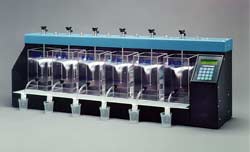
|
Phipps & Bird's new six-paddle programmable model elevates jar testing to a new level of precision by utilizing four operator-programmable memory banks that offer virtually unlimited stirring capabilities:
Constructed on a powder-coated steel uniframe chassis, the PB-900 features a fluorescent-lamp floc illuminator built into the base, and six stainless steel 1" x 3" paddles spaced six inches apart and which are adjustable to a maximum depth of nine inches. The unit comes complete with your choice of either:
Get with the program! The PB-900TM Programmable JarTester, from Phipps & Bird, the JarTest People!TM |
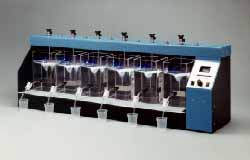 Request Information |
This six-paddle model is our basic unit, incorporating all the most-asked-for features. Constructed on a powder-coated steel uniframe chassis, six stainless steel 1" x 3" paddles are spaced six inches apart and are adjustable to a maximum depth of nine inches. Our highly reliable electronic motor control system offers regulated variable speeds of all paddles simultaneously, from 1 - 300 rpm, with the exact speed clearly displayed on a digital readout.
|
PB-750TM & PB-950TM Series Portable JarTesters
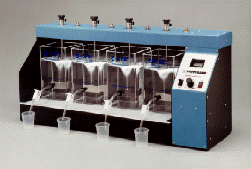 |
Like its six-paddle big brother, our PB-750TM standard four-paddle model stands at the head of its class. All the standard features of the six-paddle stirrer are included with this unit, as well. Choose either:
When ordered with the optional heavy duty carrying/shipping case, the PB-750 is ideal for polymer salesmen, health departments, or any one else performing jar tests in multiple locations. |
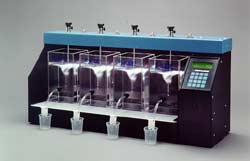 |
The PB-950TM is the unsurpassed four-paddle version of our highly acclaimed
programmable jar tester, the PB-900TM. Functionally identical to the larger model, it comes complete with everything from the operator-programmable memory banks to the dust cover. Choose either:
Add the optional heavy duty carrying/shipping case for ease of transport to multi-location sites. |
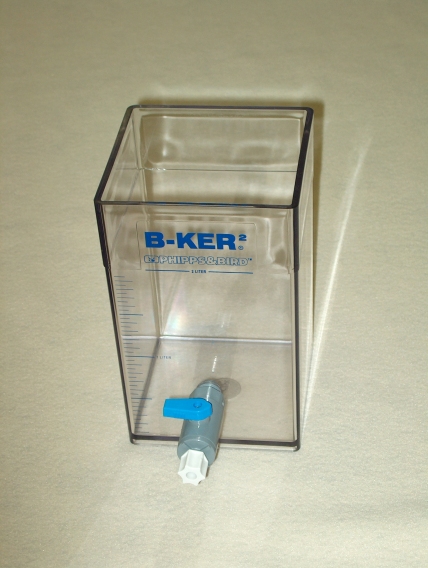 Request Information |
Now you can draw your jartest samples with a
minimum of
disturbance to the settling floc. Phipps & Bird's B-KER2® Laboratory
Jar has a sampling port conveniently located at the 10cm settling-distance
level. There's no need to raise JarTester paddles. Simply open the valve and your sample is gently drawn off.
Catalog #7790-630 |
Crown PressTM Belt Press Simulator
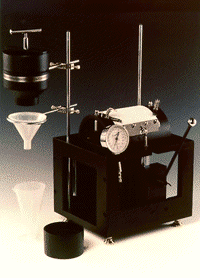 Request Information |
Now you can accurately simulate a full-size belt press, duplicating the actual dewatering process, with Phipps & Bird's Crown Press Belt Press Simulator. The unique "crown" design allows the sludge cake to react as it would under normal operating conditions, including the effects of free water motion across both the top and bottom belt faces; shear; capillary channeling; sludge migration; response to pressure changes; and the effect on filtrate flow using different types of belt material. Without shutting down the big machines, the Crown Press Simulator permits the operator to:
The Crown Press Simulator comes complete with plow simulator, carrying case and a comprehensive manual. Catalog #7800-100 |
Dissolved Oxygen Sewage Sampler
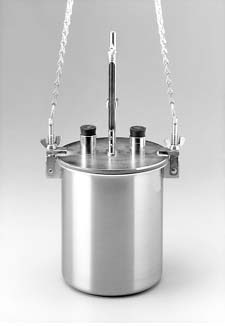 Request Information |
Our Dissolved Oxygen Sewage Sampler collects two simultaneous samples in accordance with A.P.H.A. specifications. A bucket-type sampler, it's perfect for manual spot-sampling of water or wastewater at depths up to five feet. Catalog number 8392-001.
|
 Request Information |
Take quick samples of liquids in recovery wells, storage
tanks, leachate monitoring wells, and drums with our Groundwater Sampler.
A baler-type sampler, it collects liquids at any depth over three inches.
Catalog number 8390-000
|
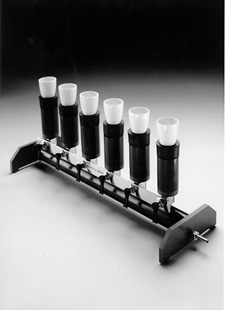 Request Information |
Ideally suited to procedures outlined in Standard Methods For The Examination
of Water and Wastewater (Solids/Residue Section) and other applications where vacuum filtration
is required.
The 8400-Series Vacuum Filtration Manifolds from the Phipps & BirdTM Family of Water Quality Equipment. |
IncuMate™ Incubation Control Module
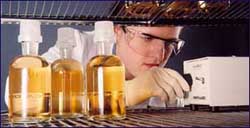
Request Information Catalog #7600-100 |
Turn virtually any refrigerator into a laboratory incubator with the IncuMate™ Incubation Control Module from Phipps & Bird. You'll get the consistently reliable test results you require at a surprisingly affordable price.
Specially designed for use by smaller water and wastewater treatment facilities, the Phipps & Bird IncuMate lets you utilize a refrigerator to perform any incubation procedure requiring a temperature range of 5° to 40°C including: biochemical oxygen demand (BOD), trihalomethane formation potential (TFP), heterotrophic plate count (HPC) and Coliform. Just place the IncuMate unit on a wire shelf in a refrigerator, make the simple electrical plug-in connections and turn it on. Refrigerators with automatic defrost modes should have the defrost feature disconnected. The module's adjustable thermostat is factory set at 20°C. To raise the temperature, turn the dial to the left; to lower the temperature turn the dial to the right. The IncuMate's built-in heater and circulating fan will operate continuously to provide thorough air circulation at the desired temperature. At start-up or after the temperature control has been reset, the temperature will stabilize in about an hour. Monitor the temperature with a quality-grade thermometer. For the smaller lab that performs a nominal number of incubations each day, Phipps & Bird's IncuMate™ Incubation Control Module is the economical alternative to high-priced incubators.
Highly reliable BOD test results don't require highly priced incubators. |
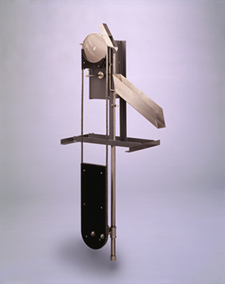 Request Information |
|
Column Filtration System (CFS)
|
Request Information |
|